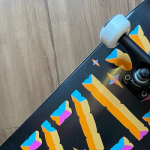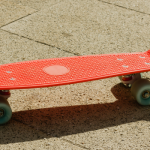Skateboard trucks are an integral part of the skateboard setup, playing a crucial role in how the board rides and turns. They are the metal T-shaped pieces that mount onto the underside of the skateboard deck. Trucks are pivotal in connecting the rider to the board and the board to the wheels, allowing for smooth and controlled movement.
The basic mechanics of skateboard trucks involve several components including the baseplate, hanger, bushings, kingpin, and axle. Each of these parts work together, contributing to the overall functionality of the skateboard. The way these components interact with each other, as well as with the skater’s movements, is what makes the magic of skateboarding possible.
In this article, we will delve deeper into the workings of skateboard trucks, exploring how each component contributes to the art and science of skateboarding. Whether you’re a seasoned skater or a curious newcomer, gaining a better understanding of these mechanics can enhance your appreciation for this dynamic sport.
Components of Skateboard Trucks:
Comprising several key components intricately working in tandem, these unassuming metal pieces are more complex than meets the eye. Let’s take a closer look at each of these individual parts and their functions:
Hanger:
The hanger is the T-shaped metal component that extends from the baseplate and holds the axle and wheels.
Its length influences the stability and turning radius of the skateboard.
Wider hangers provide more stability, making them suitable for downhill riding, while narrower ones allow for sharper turns, ideal for street and park skating.
Baseplate:
The baseplate is the flat, typically triangular metal piece that attaches the trucks to the skateboard deck.
It is mounted on the deck using four screws and determines the angle at which the trucks are positioned.
The angle of the baseplate affects the responsiveness and turning ability of the skateboard.
Kingpin:
The kingpin is the large bolt that runs through the center of the truck, holding the entire assembly together.
It plays a pivotal role in adjusting the tightness of the trucks. By tightening or loosening the kingpin nut, skaters can customize the responsiveness of their trucks.
Tighter trucks provide stability but reduce turning ability, while looser trucks enhance maneuverability at the cost of stability.
Bushings:
Bushings are the rubber or urethane components located on either side of the kingpin, serving as cushions and allowing the hanger to pivot.
They come in various shapes and durometers, influencing the overall feel of the trucks. Softer bushings allow for easier turning, while harder ones provide stability.
Skaters often experiment with different bushing combinations to achieve the desired balance between responsiveness and stability.
Axle:
The axle is the metal rod that runs through the hanger, connecting the wheels.
The length of the axle determines the width of the trucks, affecting the stability of the skateboard.
Axles are equipped with threads on the ends to secure the wheels using nuts.
Functionality of Skateboard Trucks
Now that we have explored the individual components of skateboard trucks, it’s time to understand how they work together to enable smooth and controlled movement.
Turning:
The turning capability of a skateboard is a nuanced interplay of key factors, including hanger width, kingpin tightness, and bushing durometer.
Opting for looser trucks paired with softer bushings allows for agile and sharp turns, rendering them ideal for the dynamic landscapes of street and park skating.
Conversely, tighter trucks featuring harder bushings enhance stability, making them the preferred choice for the controlled descents of downhill cruising.
Stability:
Stability forms the bedrock of various skateboarding styles, particularly in the realms of downhill riding and ramps.
Achieving a stable setup involves strategic choices such as opting for wider hangers, tightening kingpins, and selecting harder bushings.
This combination not only enhances control but acts as a deterrent against unwarranted wobbling, especially when hurtling down slopes at high speeds.
Customization:
Skateboarders, akin to artists with their canvases, revel in the art of customization.
Experimentation becomes a cornerstone as skaters delve into the realms of hanger width, baseplate angle, kingpin tightness, and bushing durometer.
This bespoke approach empowers riders to fine-tune their trucks, sculpting a ride that aligns precisely with their unique style and preferences.
The pursuit of this personalized equilibrium between stability and maneuverability is a testament to the limitless customization potential embedded within skateboard trucks.
Conclusion:
Skateboard trucks are a sophisticated assembly of components that determine the turning ability, stability, and overall feel of a skateboard.
Understanding the function of each part allows skaters to fine-tune their trucks and optimize their setup for a personalized and enjoyable riding experience.
Whether cruising down hills, navigating tight corners, or performing tricks in the skatepark, the trucks play a pivotal role in shaping the dynamics of skateboarding.
![Why do skateboarders hate scooters? [Reasons + Tips] Why do skateboarders hate scooters? [Reasons + Tips]](https://bedoper.site/wp-content/uploads/2023/04/Why-do-skateboarders-hate-scooters-150x150.png)


![How fast do skateboards go downhill? [90 mph (145 km/h)] How fast do skateboards go downhill? [90 mph (145 km/h)]](https://bedoper.site/wp-content/uploads/2023/04/How-fast-do-skateboards-go-downhill-150x150.png)
